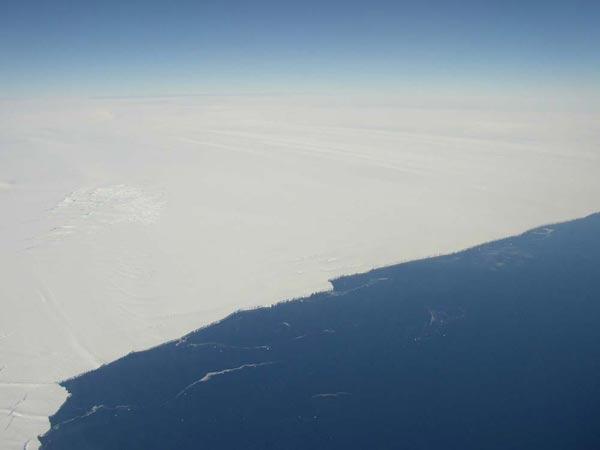
What's Causing an Antarctic Glacier's Rapid Melt?

A major glacier in Antarctica is melting unusually quickly because ocean currents are undermining it from below, researchers find.
An international team of scientists investigated the Pine Island Glacier Ice Shelf in western Antarctica, a floating tongue of ice where a land-bound glacier meets the Amundsen Sea. It averages about 44 miles long by 22 miles wide (70 kilometers long by 35 kilometers wide).
"We call it 'the PIG,'" said researcher Stan Jacobs, an oceanographer at Columbia University's Lamont-Doherty Earth Observatory. "The Amundsen Sea is a very remote place, far from any port, and historically has sea ice cover there nearly all year round, but with icebreakers and persistence, we have been able to reach the PIG twice."
Researchers are closely watching Pine Island Glacier and other ice shelves in Antarctica for their potential to dramatically alter coastlines worldwide. Global sea levels are currently rising at about 0.12 inches (3 millimeters) per year, and one estimate suggests the total collapse of Pine Island Glacier and its tributaries could raise the sea level by 9 inches (24 centimeters).
Rapid melting
Unusually, in a 2009 expedition there aboard an icebreaker, the scientists found that melting beneath the ice shelf had risen to about 19 cubic miles (80 cubic kilometers) a year, a rate 50 percent higher than 15 years ago. Although regional ocean temperatures had also warmed slightly, by about 0.3 degrees Fahrenheit (0.2 degrees Celsius), that was not enough to account for this jump. [In Images: Trekking to a Treacherous Glacier ]
Robotics helped discover the apparent cause of this rapid melting. On the 2009 cruise, researcher Adrian Jenkins at the British Antarctic Survey and his colleagues sent a robot submarine beneath the ice shelf, revealing an underwater ridge. The researchers think this ridge once slowed the glacier like a giant retaining wall, but when the receding glacier detached from the ridge sometime before the 1970s, warm deep water gained access to deeper parts of the glacier.
Sign up for the Live Science daily newsletter now
Get the world’s most fascinating discoveries delivered straight to your inbox.
Over time, changes in ocean circulation with currents underneath the ice shelf rising in speed by about 75 percent on average led a giant cavity to grow in the glacier, one about 120 cubic miles (500 cubic km) in size. With less friction between the ice shelf and seafloor, the land-bound glacier accelerated its slide into the sea to its current speed of 2.5 miles (4 km) per year.
The fact that Antarctica might have gotten windier in recent decades could help explain these changes in ocean flow. Stronger winds around the continent would tend to push sea ice and surface water north, which in turn would allow more warm water from the deep ocean to upwell into western Antarctic ice shelf cavities, Jacobs said.
Bubbling surprise
One day, the researchers actually directly saw the strength of the melting process near the southern edge of Pine Island Glacier Ice Shelf, with frigid seawater seemingly boiling on the surface like a pot on the stove. This suggests that deep water, buoyed by added fresh glacial melt, was rising to the surface in a process called upwelling.
"It is very surprising to have this happen near a typical Antarctic ice shelf, as melting is usually not strong enough for it to occur," Jacobs said. Similar activity has been observed in the fjords of Greenland , where summer runoff and melting glacier fronts can also drive buoyant plumes to the sea surface.
A key lesson of these findings "is that we have to pay attention to more than just ocean temperature," Jacobs told OurAmazingPlanet. "Changes in ocean circulation and its average velocity can also increase melting of these ice shelves."
The scientists detailed their findings in the June 26 issue of the journal Nature Geoscience.










